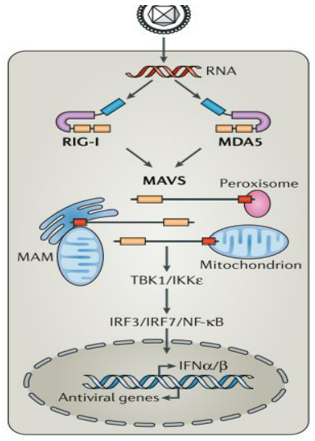Introduction
Double-stranded RNA (dsRNA) is a viral product, which is produced by positive-strand RNA viruses, dsRNA viruses, and DNA viruses. However, negative-strand RNA viruses are not shown to generate any significant dsRNA signals (1). Creative Diagnostics offers a range of anti-double-stranded RNA monoclonal antibodies, which can be used for the in Vitro detection of the dsRNA intermediates of various RNA viruses and diagnosis research, also can contribute to the RNAi research (2) and could potentially be used in gene therapy (3).
Background
Double-stranded RNA (dsRNA) is a viral product that induces innate immunity, leading to the production of interferon (IFN) alpha and beta, which activate hundreds of IFN-stimulated genes that confer viral resistance (4). dsRNAs over 30 bp in length have been reported to be key activators of the innate immune response against viral infection. Host cell interactions with dsRNA can occur in a number of ways. Primarily, specific receptors activate the synthesis of IFN alpha and beta, antiviral proteins, and dsRNA-activating enzymes that block viral replication (5). dsRNA replication of all dsRNA viruses is shown to occur in the cytoplasm.

Fig 1. dsRNA activates antiviral innate immune signaling through intracellular receptors
dsRNA antibodies have been used extensively to detect and characterize plant and animal viruses with dsRNA genomes or intermediates, and are efficient tools for the detection of dsRNA in cell culture and tissues such as in vitro transcribed mRNA preparations and for the quality control of mRNA preparation.
Various pattern recognition receptors (PRRs) can recognize mRNA transcripts in vitro (6). ssRNA can be recognized by endosomal innate immune receptors such as toll-like receptor 7 (TLR7), TLR8. dsRNA can be recognized by endosomal innate immune receptors (eg TLR3) and cytoplasmic innate immune receptors (PKR, RIG-I, MDA5 and OAS). On this basis, dsRNA products can stimulate the secretion of pro-inflammatory cytokines and type I interferon (IFN), leading to the activation of antigen-presenting cells (APCs) and the generation of inflammatory responses. However, they can also activate antiviral enzymes, resulting in stalled mRNA translation and mRNA degradation.
Reagents Solutions
Creative Diagnostics provides a serial of monoclonal antibodies against double-stranded RNA that can be used for the in-vitro detection of the dsRNA in transcribed mRNA preparation and diagnosis research of viral infection. Our antibodies combine high affinity and specificity, and are more flexible for the simultaneous detection of dsRNA with different markers. All of these antibodies are well-validated with abundant quality control data.
Highlights
- High Affinity: Perfect tools to detect pathogens, including detection in paraffin-embedded fixed tissue samples, cells, and tissues.
- High Specificity: No reaction with ssRNA, ssDNA or dsDNA.
- Broad Applications Covered: Immunofluorescence microscopy, dsRNA-Immunoblotting, Immunoaffinity Chromatography, Nucleic Acid ELISA, IHC, FC, DB.
- Different Isotype: More flexibility for the simultaneous dsRNA detection with different markers.
- Positive control available upon request: synthetic dsRNA (dsRNA 142 bp).
References
- Boersma S, Rabouw H, Bruurs L, et al. (2020). Translation and Replication Dynamics of Single RNA Viruses. Cell.
- Clark D P and Pazdernik N J. (2016). RNA-Based Technologies
- Shao W, Earley L F, Zheng C, et al. (2018). Double-stranded RNA innate immune response activation from long-term adeno-associated virus vector transduction. JCI Insight. 3(12).
- Ogden K M. (2015). Prasad B Quelling an innate response to dsRNA. Oncotarget. 6(30):28535-6.
- Zharkov M I, Zenkova M A, Vlassov V V, et al. (2019). Molecular Mechanism of the Antiproliferative Activity of Short Immunostimulating dsRNA. Frontiers in Oncology. 9:1454.
- Linares-Fernández S, Lacroix C,Exposito, J Y,Verrier, B. (2019). Tailoring mrna vaccine to balance innate/adaptive immune response. Trends in Molecular Medicine. 26(3).

